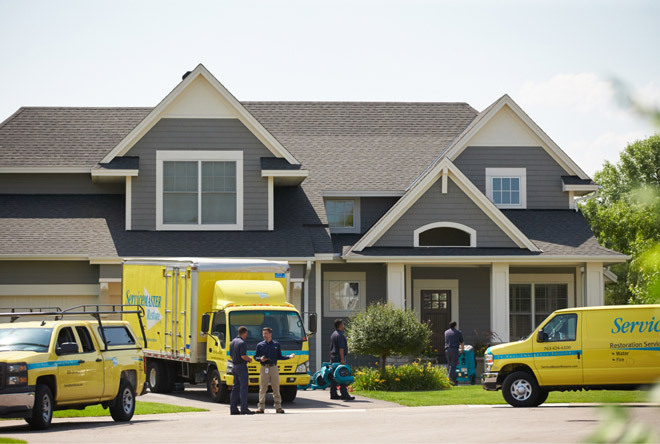Water Damage Restoration in Anchorage
Water damage in your home can be a devastating experience. Whether it's a burst pipe, a leaky appliance, or a natural disaster, the consequences can be far-reaching, impacting the structure, belongings, and even your health. At ServiceMaster of Anchorage, we understand the urgency and stress associated with water damage, and we're here to provide comprehensive restoration services to get your life back on track.
Call us at (907) 802-5450 or contact us online for water damage repair in Anchorage today!
Our Expertise in Water Damage Restoration
Our team of experienced and certified professionals is equipped to handle any water damage situation, big or small. We utilize advanced techniques and state-of-the-art equipment to ensure a thorough and efficient restoration process. Our services encompass:
Emergency Water Extraction
Time is of the essence when it comes to water damage. Our team arrives promptly equipped with powerful submersible pumps and high-capacity extraction units. These remove standing water efficiently, minimizing the spread and preventing further damage to surrounding materials. We strategically position the equipment to ensure thorough extraction, even from hidden areas like crawl spaces and under-cabinets.
Structural Drying
Once the excess water is removed, we meticulously dry the affected areas to prevent the growth of mold and mildew, which thrive in damp environments. We employ industrial-grade dehumidifiers specifically designed for water damage restoration. These powerful machines remove excess moisture from the air, creating optimal drying conditions. Additionally, we strategically place high-velocity air movers to promote air circulation and accelerate the drying process. This combined approach ensures even and complete drying, preventing the hidden dangers of lingering moisture.
Content Cleaning and Restoration
We understand the sentimental value attached to your belongings. Our content cleaning and restoration specialists meticulously clean and restore salvageable items like furniture, carpets, upholstery, and personal items. We utilize specialized cleaning solutions and advanced techniques to remove dirt, grime, and water stains while preserving the integrity and appearance of your valuables. Depending on the extent of the damage, some items may require off-site cleaning and restoration in our specialized facilities.
Mold Remediation
If mold growth is present due to water damage, we prioritize the health and safety of your family by implementing safe and effective mold remediation protocols. Our technicians utilize advanced containment procedures and negative air pressure technology to isolate the affected area, preventing the spread of mold spores throughout your home. We then safely remove the mold using EPA-approved products and specialized equipment, ensuring complete eradication and preventing future recurrence.
Reconstruction and Repair
Once the drying and cleaning processes are complete, our skilled technicians assess the need for any necessary repairs or reconstruction work. This may involve repairing damaged drywall, flooring, subflooring, and other structural elements. We utilize high-quality materials and expert craftsmanship to restore your home to its pre-damage condition, ensuring both structural integrity and aesthetic appeal. We work closely with you throughout the process, keeping you informed and involved in every step of the reconstruction.
Why Choose ServiceMaster of Anchorage for Water Damage Restoration?
24/7 Emergency Response: We understand that water damage emergencies don't wait for convenient hours. Our team is available 24/7 to respond promptly and mitigate the damage as quickly as possible.
Certified and Experienced Professionals: Our technicians are highly trained and certified in water damage restoration best practices. They possess the knowledge and expertise to handle any situation effectively and efficiently.
Advanced Technology and Equipment: We utilize the latest technology and equipment in the industry to ensure a thorough and efficient restoration process. This includes advanced moisture detection tools, industrial-grade drying equipment, and specialized cleaning solutions.
Open Communication and Transparency: We believe in clear and consistent communication throughout the restoration process. We keep you informed of every step and address any questions or concerns you may have.
Focus on Customer Satisfaction: Our ultimate goal is your complete satisfaction. We strive to exceed your expectations by providing exceptional service, high-quality workmanship, and a seamless restoration experience.
Beyond Restoration: Peace of Mind and Support
We recognize that water damage can be a highly stressful and emotionally challenging experience. Our team goes beyond simply restoring your home; we offer support and guidance throughout the process. We can assist with insurance claims, provide helpful resources, and answer any questions you may have about the restoration process and its impact on your property.
Don't Hesitate to Contact Us
If you're facing water damage in your Anchorage home, don't hesitate to contact ServiceMaster of Anchorage. We're here to help you navigate this challenging situation with professionalism, expertise, and compassion. Our prompt response, advanced techniques, and commitment to customer satisfaction ensure a smooth and successful restoration process, allowing you to focus on what matters most – getting your life back to normal.
DIAL(907) 802-5450 FOR assistance!


